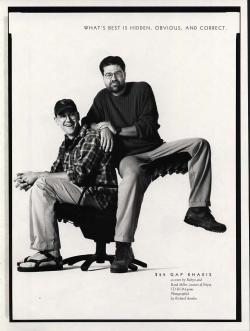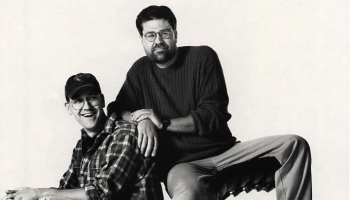 “You wouldn’t understand. You had to be there.”
“You wouldn’t understand. You had to be there.”
Maybe it’s just me, but I’ve always felt that that idiom is an absolutely ridiculous turn of phrase. Why would you have to be anywhere specific to understand something?
And yet, there are some things that are so unbelievable they only really make sense if you were there to experience it for yourself.
We’ll look at two such examples for this edition of Bite-Sized Game History, as well as a third that is so wild you might not believe it even if you were there (or anywhere for that matter).
![]() You can find a lot of dedicated video game historians on Twitter, and in 280 characters or less, they always manage to unearth some amazing artifacts. Bite-Sized Game History aims to collect some of the best stuff I find on the social media platform.
You can find a lot of dedicated video game historians on Twitter, and in 280 characters or less, they always manage to unearth some amazing artifacts. Bite-Sized Game History aims to collect some of the best stuff I find on the social media platform.
It’s 1995. Your legs are clad in a pair of khakis from The Gap and a copy of Myst is spinning in your brand new CD-ROM tray. You might think that these two markers of the mid 90s are unrelated, but you would be wrong.
Myst was nothing short of a phenomenon between the game’s launch in 1993 and the release of Riven: The Sequel to Myst in 1997, and developers Rand and Robyn Miller received praise from all corners for helping to usher in the multimedia revolution. Out of one of those corners came advertising executives from The Gap, who signed the brothers to model the store’s signature khakis for a print campaign in 1995.
Sitting under an advertising slogan (“What’s Best is Hidden, Obvious, and Correct”) that could double as a thesis statement for Myst itself, the developers helped create a one-of-a-kind image, which was recently shared by indie game developer Michael Klamerus:
Apologies for posting this ad once again, but have there been any game designers that have modeled clothing aside from the designers of Myst? Surely there must be others?Controversial limitation but I’m not counting their own merch
— Michael Klamerus (@MichaelKlamerus) August 15, 2022
[Tweet Hidden – View at Internet Archive]
With more than 1.5 billion iOS devices currently in operation, the available audience for mobile games far surpasses that of PCs or consoles. Though video games have a huge presence on the iOS App Store, executives at Apple have made only fleeting gestures towards at capturing that audience, but that wasn’t always in the case.
In 1999, Steve Jobs wanted to challenge Microsoft Windows as the home for desktop gaming, and he turned to a then-small company known as Bungie to lead his attack. Long before their association with the Xbox, Bungie had built up a reputation as a Mac-first developer with the release of first person shooters Pathways Into Darkness (1993) and Marathon (1994), as well as the strategy game Myth: The Fallen Lords (1997).
This all led to Macworld 1999, where Jobs introduced The Halo Project to the public as the centerpiece of Apple’s big gaming push. The game that would eventually evolve into Halo: Combat Evolved was originally conceived as a third-person shooter, and Bungie co-founder Jason Jones gave attendees their first glimpse at a Warthog tearing through the desert, as well as a few robotic soldiers engaging some aliens in a firefight.
Halo shifted to a first-person perspective when Bungie was acquired by Microsoft less than a year later, but you can see what could have been in this recording of Jobs’s Macworld 1999 introduction recently shared by Launcher’s Gene Park:
Steve Jobs first introduced Halo, which is so trippy pic.twitter.com/XQq05rt0ME
— Gene Park (@GenePark) September 7, 2022
Finally, you may want to sit down, because this one is about to get wild.
Indie developer John “Ducky” Szymanski has a theory about why some game consoles succeed and why some fail. It’s got some wild twists and turns, but it’s also pretty airtight. According to Szymanski, sales success isn’t predicated on the battle between bits and bytes, or which console pushes the most polygons, it has to do with the size of the controller.
I know, it sounds insane. But just look at Nintendo’s console history. The NES steamrolled the competition with more than 61 million units sold, but as the controllers grew in size, the sales declined. The Super NES, Nintendo 64, and GameCube all sold worse than the console that came before. It was only after the Wii debuted alongside the Wii Remote that Nintendo was able to reverse their fortunes. But if you recall, that momentum was immediately derailed after the launch of the Wii U’s gargantuan tablet controller, and only the Switch’s svelte Joy-Con controllers could right the ship. The theory even holds among consoles within a generation. The system with the smallest controller will always be the market leader when all is said and done.
Szymanski couldn’t say with any certainty why this is happening, but he did suggest that kids could be a larger portion of the population buying consoles than we thought:
A theory that has been haunting me:
Console's success isn't based off of exclusive games or marketing – it's all about how small their controller is.
?
— John Szymanski, "Ducky" (@Ducky_Szymanski) September 11, 2022
Thanks to Michael Klamerus, Gene Park, and John “Ducky” Szymanski for providing these borderline unbelievable bits of video game history. If you’d like to see more of this kind of thing, be sure to follow me on Twitter.

